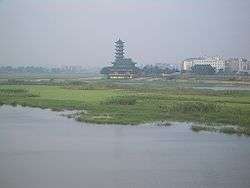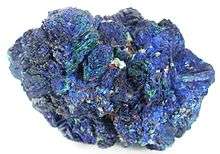Daye, Hubei
| Daye 大冶市 | |
|---|---|
| County-level city | |
|
Daye Lake on the southern edge of Daye's urban core. The Qing Long Ta ("Purple Dragon Pagoda") is in the middle. | |
 Daye Location in Hubei | |
| Coordinates: 30°06′N 114°59′E / 30.100°N 114.983°ECoordinates: 30°06′N 114°59′E / 30.100°N 114.983°E | |
| Country | People's Republic of China |
| Province | Hubei |
| Prefecture-level city | Huangshi |
| Area | |
| • Total | 1,460 km2 (560 sq mi) |
| Elevation | 25 m (82 ft) |
| Population (2000) | |
| • Total | 813,600 |
| • Density | 560/km2 (1,400/sq mi) |
| Time zone | China Standard (UTC+8) |
| Website | http://www.hbdaye.gov.cn/ |
Daye (Chinese: 大冶; pinyin: Dàyě) is a city of eastern Hubei province, People's Republic of China. Administratively, it is a county-level city of Huangshi City.
Before the adoption of the Hanyu Pinyin, the name of the city was often transcribed in English as Tayeh.[1]
As it is usually the case with county-level cities, Daye includes both an urban core and a fair amount of rural land in all directions, with smaller townships (zhen) such as Dajipu (大箕铺). According to the Fifth Population Census of China (2000), the entire county-level city of Daye had 813,600 residents, with a population density of 558 people per square kilometer.[2]
The Daye Lake south of Daye's urban core is surrounded by parks and fishing ponds, and is a popular place for recreation.
For a traveler who goes on G316 from Wuhan toward the south-east, Daye appears as a border between the more urban and more rural parts of the province. Daye sits on the south-eastern border of the heavily industrialized Wuhan/Ezhou/Huangshi metropolitan area; south of it, the much more rural Yangxin County begins.
Economy
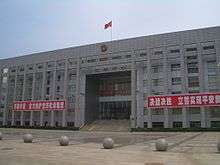
Daye is an industrial city, a center of mining[3] and metallurgy, both ferrous and non-ferrous; its name means 'Big Smeltery'.
According to archaeologists, copper mining and smelting was conducted at Daye's Tonglüshan Mine (铜绿山, 30°04′52″N 114°56′07″E / 30.08111°N 114.93528°E) as early as the Spring and Autumn period (6th century B.C.E.), if not earlier.[4] Tonglüshan Mine is located just southwest of the modern city, and now has a museum.[5]
Although such copper-containing minerals as malachite and azurite are found here, the local ores are actually richer in iron than in copper, and the modern Daye is better known for its iron ore mining and processing.[4]
Among the major employers is Huangshi Daye Non-ferrous Metals Co., Ltd.[6]
Transportation
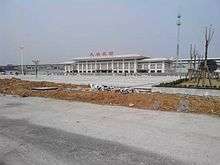
Daye was the junction of the Wuhan-Daye Railway (completed in 1958) and Daye-Shahejie Railway (completed in 1987), which merged in 1989 to form the Wuhan–Jiujiang Railway. Huangshi Railway Station, which is the main passenger station for the entire Huangshi metropolitan area, is actually located within Daye's administrative borders, about 6 km north of downtown Daye (30°9′23″N 114°56′5″E / 30.15639°N 114.93472°E). It has fairly frequent service, with travel time to Wuhan being typically around 1 hour on a high-speed D-series train, or 1.5 hours on a "conventional" passenger train.[7]
Daye is served by the Wuhan–Huangshi Intercity Railway, part of the future Wuhan Metropolitan Area Intercity Railway, which opened in 2014. The new Daye North Railway Station, located north-east of Daye's main urban area (30°07′31″N 114°59′45″E / 30.125216°N 114.995895°E), serves as that line's terminal. It has fairly frequent service (about hourly) to the Wuhan Railway Station. Construction work is carried out to extent this rail line beyond Daye; this will become the Wuhan–Jiujiang Passenger Railway (estimated completion date, 2017).
Daye is also served by the China National Highway 106 (which coincides in this area with China National Highway 316).
History
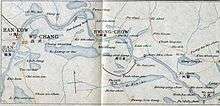
Daye County existed on and off for centuries; as recently as the World War II period, it included much of today's prefecture-level city of Huangshi. This means that pre-1949 references to a location in "Daye" or "Tayeh" may actually refer to anywhere within today's Huangshi.
Daye County was re-established on June 1, 1962, on a rather smaller scale, as part of Huangshi City. On February 18, 1994 Daye was converted into a county-level city, still within the prefecture-level city of Huangshi.[8]
Dialect

The speech of Daye and the adjacent counties farther south (toward the Jiangxi border) has been traditionally characterized as the Daye dialect, part of the Datong dialect group of Gan Chinese.[9]
References
- ↑ Bureau of Mines / Minerals yearbook area reports: international 1971 (1971).
- ↑ Huangshi population statistics, as reported by Huangshi Prefecture-Level City Government
- ↑ Fengjiashan Mine (Daye Copper mine), Edong Mining District, Daye Co., Huangshi Prefecture, Hubei Province, China
- 1 2 Wagner, Donald B. (1993), Iron and Steel in Ancient China, Volume 9 of Handbook of Oriental Studies: Section 4, China (2 ed.), BRILL, pp. 42–47, ISBN 9004096329
- ↑ Museum of the Former Site of Ancient Tonglüshan Copper Mine
- ↑ Huangshi Daye Non-ferrous Metals Co., Ltd.,
- ↑ Huangshi schedule, as of late 2013 (Chinese)
- ↑ The Founding of Huangshi
- ↑ Daye topolect
External links
| Wikimedia Commons has media related to Daye. |
- Daye City People's Government (Chinese)
